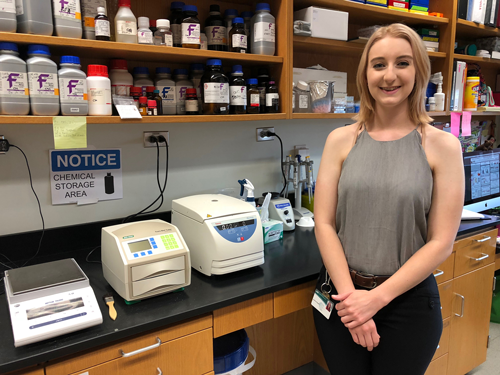Forty percent of adults in the United States are obese, classified as having a BMI greater than 25.
This statistic is shocking considering that obesity is a significant risk factor for several serious illnesses, like heart disease, liver disease, diabetes and cancer. In the interest of our country’s health, there is a critical need for effective treatments for obesity.

Jessica Kepple is a third-year Ph.D. student whose research could one day help turn the tide in the fight against obesity in the United States.
To understand the implications of Kepple’s research, we have to know a little something about our body fat. Specifically, we need to know more about fat than “how much cardio do we need to do to get rid of it” (although the saying that “cardio burns fat” is not technically incorrect). There are actually two main types of fat in our bodies with very different functions, and cardio only burns one of them.
When most people think of fat they think of white fat. White fat lies just beneath the skin and around your tummy surrounding your organs. This is the fat that you are working to get rid of when you exercise. This white fat functions to store energy. In other words, if we eat more calories than we need, that energy will be converted to white fat to be stored for later use. Having too much white fat can put you at risk for many metabolic diseases. The other type of fat in our bodies, brown fat, is quite different. Brown fat actually uses energy to produce heat. Instead of storing calories like white fat, brown fat will burn calories to produce heat either in response to cold to help maintain your body temperature or in response to a high calorie diet to help limit weight gain.
This brown fat, or brown adipose tissue (BAT), is a key player in Kepple’s research and a potential treatment for obesity. A body with more active brown fat will burn more calories than it stores, resulting in weight loss or weight maintenance. Thus, if we could “turn on” BAT’s function artificially, we could both start and speed up the weight loss process.
Sounds easy, right? Just turn on the BAT functions, and watch the pounds roll off.
Unfortunately, triggering BAT activity isn’t quite so straightforward.
 BAT activity is triggered naturally by cold exposure, and BAT activity has also been shown to increase when an individual is taking in too many calories to help limit weight gain. However, the first drug that scientists tried to induce BAT activity artificially was unsuitable for humans. The issue comes down to how BAT decides to start producing heat (and burning those calories).
BAT activity is triggered naturally by cold exposure, and BAT activity has also been shown to increase when an individual is taking in too many calories to help limit weight gain. However, the first drug that scientists tried to induce BAT activity artificially was unsuitable for humans. The issue comes down to how BAT decides to start producing heat (and burning those calories).
BAT doesn’t decide what to do for itself. BAT has tiny, cellular level receptors on its surface that receive chemical messages released by neurons in the brain that tell BAT to start producing heat. So, the first drugs scientists administered were intended to stimulate those receptors, which neurons use to activate BAT function. The issue arose because of off target effects of the drug in tissues like the heart, which also have similar receptors for chemical messages from neurons in the brain. While the heart’s receptors are different from BAT’s, the receptors are so similar that the heart was also stimulated to become more active, increasing the risk of heart attack in humans.
 The challenge for scientists now is to find a way around this obstacle. In other words, we want to stimulate only BAT and leave the heart (and other organs) to do their thing uninterrupted.
The challenge for scientists now is to find a way around this obstacle. In other words, we want to stimulate only BAT and leave the heart (and other organs) to do their thing uninterrupted.
Kepple’s research focuses on a tiny cellular mechanism that could be the key to this locked door. It has been named Ldb1, which is a scaffolding protein that holds together transcriptional complexes (other proteins that regulate gene expression). For those who haven’t taken a biology class recently, transcription is the first step of gene expression, and gene expression, roughly speaking, is the way that instructions for how the body works are communicated from our DNA to our cells. Targeting Ldb1 and tissue specific interacting partners with a drug treatment could enable scientists to alter the way that BAT functions without affecting other parts of the body that are governed by different genes.
Clearly, Kepple’s research has huge implications for the possible development of a drug treatment for obesity. To Kepple, this is part of what excites her about the research she is doing; the potential for her research to be translational is an exhilarating prospect. UAB is a great place for scientific research to cross the border into new medical practices and treatments, and in Alabama, the state in the U.S. with the second highest rate of obesity, we can only look forward to such a treatment for obesity being developed.